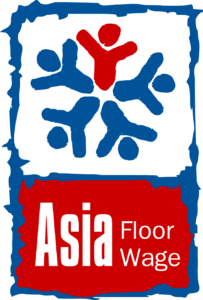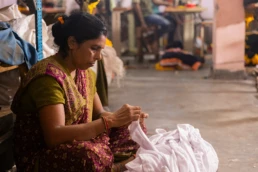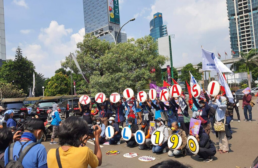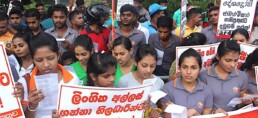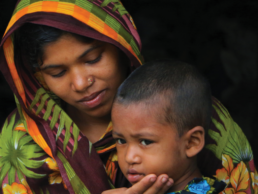Dindigul Agreement resolves gender-based garment worker violence
Written by Shemona Safaya for Just Style (28 June 2023)
Read Article
Garment Workers in Asia Need ILO Convention 190
June 23, 2023Stories from the Field,gender violenceOpinion,C-190,ILO C-190,GBVH,gender based violence and harassment
“Ijah, you know, right, if you take maternity leave, your contract will expire? So don’t even think of taking maternity leave," said the factory supervisor one afternoon when Ijah was about to leave her line to rest.
"I don't understand, ma'am. You cut my wages and my menstrual leave compensation after my pregnancy started showing,” Ijah cried, frustrated that she wasn’t even getting to rest during her pregnancy. However, the supervisor insisted that Ijah wouldn’t be able to take her maternity leave because her contract would expire. Indonesia’s labor law stipulates three months of maternity leave, but Ijah’s contract would have ended by the time she is due.
Ijah has been working as a contract worker since she was a young woman in the Cakung Industrial Area in North Jakarta, Indonesia. She is now 35 years old, married with two children and a third on the way, and still hasn’t received ‘permanent worker’ status.
This is due to a common but illegal practice in Indonesia's garment industry where factories frequently hire workers for no longer than three months at a time. Consequently, employees like Ijah are forced to move from one factory to another without severance pay, often working anywhere from 30 days to 3 months at each location. A significant number of these workers are women who, consequently, are forced to forfeit essential social security benefits such as menstrual and maternity leaves. Ijah, like many others, can only hope her contracts are repeatedly renewed until she gets old and weary.
When fashion companies in the Global North started to look for labor markets in the Global South, the garment sector was positioned as a promise of economic and social upliftment for millions across Asia. However, the industry has become a hotbed of gender-based violence and harassment (GBVH), particularly for women. A recent global International Labour Organization (ILO) study found that 22.8% or 743 million persons in employment had experienced at least one form of violence and harassment at the workplace. While data on sexual violence is scarce, more so at the regional level, available studies indicate particularly high rates in some countries.
In 2021, the ILO Better Work program reported that approximately four out of every five workers in Indonesian factories expressed concern about sexual harassment at work. In the same study, 42.5% of women workers from Myanmar said they had been sexually harassed at work. In Vietnam, 19.8% of female workers and 11.9% of male workers reported that they had experienced at least one form of violence in the previous six months (CARE International 2020).
C190: Promise of a safe work environment
The ordeals that Ijah and countless other garment workers have to endure, day in and day out, teeter on the line of outright violence and incessant harassment. It is a stain on human rights that such flagrant violations persist globally, not only in the workplace but also in homes and public spaces. The cost is not just economic; it seeps into the very fabric of our societies, burdening individuals, families, and entire communities. The bleak reality is that these abuses persist, unchecked and unimpeded, despite their clear illegality, with emboldened perpetrators taking advantage of the fear of the most vulnerable of workers.
Everyone is entitled to a workplace where dignity and safety aren't mere luxuries but inherent rights. This includes freedom from violence and harassment of any kind, especially when it's gender-based.
Recognizing this right as paramount, the ILO, in June 2019, adopted the first international treaty on workplace violence and harassment – Convention 190 (C190) and its accompanying Recommendation 206 (R206). The treaty came into effect on 25 June 2021.
Governments pledging support to C190 have a duty to enact necessary laws and policies to counter and eliminate workplace violence and harassment. The treaty rightly identifies women and other vulnerable groups as being at an escalated risk of these rights abuses – a reality that is particularly acute during times of crises, like a global pandemic. It thus calls for an inclusive, gender-sensitive, and integrated approach to put a definitive end to all forms of violence and harassment at work.
C190 and R206 represent a historic chance to mold a future of work that is rooted in dignity and respect for everyone. But, even two years after its inception, the journey to realizing safe and GBVH-free workplaces remains daunting. It's disheartening that in Asia, not a single country has embraced C190 and R206. Local laws may exist on paper in these nations, promising protection to workers, but they're routinely overlooked or breached – all for the sake of productivity and profit.

Let’s take a quick look at the state of affairs in some of the major garment-producing markets in South and Southeast Asia.
Indonesia:
Between 2020 and 2021, the Central Board of Serikat Pekerja Nasional (SPN), Lembaga Informasi Perburuhan Sedane (LIPS), and the Workers' Rights Consortium (WRC) conducted a study of 12 garment supplier factories in Java Island and found that the most prevalent types of GBVH included:
- Verbal violence (yelled at, rudely called, insulted, threatened, asked out to date, seduced, sexual chat)
- Physical violence (hit, kicked, grabbed, thrown, poked with fingers, touched, hugged, peeked at, buttocks grabbed, bra straps pulled)
- Other forms of violence such as physical punishment, increasing production targets or working hours, and withholding maternity leave and menstrual leave
Although the study doesn’t give sexual violence its own category, under the definition given by ILO C-190, actions like ‘asked out to date, seduced, sexual chat’ and ‘poked with fingers, touched, hugged, peeked at, buttocks grabbed, bra straps pulled’ would constitute forms of sexual violence.
“GBVH is corrosive to women workers’ sense of self and makes them voiceless and powerless, while also becoming a barrier to their accessing other fundamental rights such as freedom of association and living wage,” says Sumiyati, Chair of SPN Women’s Committee and member of AFWA Women’s Leadership Committee (WLC). Fashion brands must make concrete commitments to understanding and addressing risk factors for GBVH across their supply chains through a ground-up approach that upholds respect for freedom of association and is led by workers and trade unions (AFWA, 2021). Sumi continues, “Factories need to be converted into GBVH-free zones, but workers cannot do this alone.”
Sri Lanka
GBVH prevalence in Sri Lankan workplaces stems from patriarchal norms, power imbalances, gender equality ignorance, lax policy enforcement, and insufficient victim support. These issues are exacerbated by hierarchical work structures where those in power exploit their authority. Although the government has legislated protections such as the Employment of Women, Young Persons, and Children Act, the Penal Code, and the Sexual Harassment Act, their enforcement is often inconsistent.
A 2021 study by AFWA on GBVH during the COVID-19 pandemic found that many young mothers had been forced to resign after the factory they worked in refused to reopen the creche. Many others had to leave their children in their village homes, to be cared for by elderly parents, while they went to the city for work.
Various NGOs, trade unions, and civil society groups in Sri Lanka are actively working to combat GBVH by raising awareness, offering victim support, advocating policy changes, and promoting gender equality through training and capacity building. Efforts to foster safe, inclusive work environments via gender-sensitive policies, awareness campaigns, and stakeholder training are underway.
Cambodia
In 2019, the Garment, Footwear, and Travel Goods sectors contributed 57% to Cambodia's total exports and employed 808,223 workers, 80% of whom were women. These workers, primarily rural migrants, often endure substandard living conditions in city rentals marked by poor hygiene, high costs, and low security. Despite their significant presence in these industries, female workers face hardships due to their limited education and societal norms. The persistence of male dominance, particularly in higher positions within factories, further exacerbates their plight.
A 2021 study by AFWA found that Cambodian workers were too afraid to take bathroom breaks for fear of verbal abuse if their daily production targets were not met. They would limit themselves to a single break per day, hold in their urine for a long time, or even restrict water intake, despite being aware of the risk of urinary tract infections or suffering regular stomach and bladder pain.
In another instance, all workers received less than half of the monthly minimum wage when work was suspended after brands cancelled or reduced orders during the pandemic. Women workers were disproportionately impacted by the illegal wage deductions and didn’t even receive the monthly US$70 mandated by the government.

India
India's struggle with gender inequality and violence against women extends into workplaces, particularly the female-dominated garment industry. Fear of backlash, social stigma, and unawareness of their rights often discourages victims from reporting harassment, perpetuating a culture of silence.
Several legislative measures exist to combat these issues:
- The Sexual Harassment of Women at Workplace Act (POSH), 2013, mandates safe working conditions and complaint-handling mechanisms.
- The Factories Act, 1948, establishes health and safety standards in garment factories.
- The Maternity Benefits Act, 1961, provides protections for pregnant and new mothers.
- The National Policy for Women, 2016, aims to tackle gender disparities and foster safe work environments.
However, enforcement gaps and patriarchal attitudes hinder the effectiveness of these laws. Various government bodies, NGOs, and industry stakeholders are working to raise awareness and increase sensitivity towards these issues. More recently, increasing emphasis has been placed on addressing workplace GBVH, including in the garment industry. At the same time, greater effort needs to be put into creating safe and inclusive environments for women, strengthening law implementation, and promoting gender equality.
One successful effort towards this is the Dindigul Agreement to Eliminate Gender-based Violence and Harassment. In April 2022, Indian women- and Dalit-worker-led union TTCU signed a historic agreement with clothing and textile manufacturer Eastman Exports to end GBVH at Eastman Exports’ factories in Dindigul, in the southern state of Tamil Nadu in India. TTCU, GLJ-ILRF, and AFWA also signed legally binding agreements with multinational fashion companies and their supplier to build a safe and GBVH-free workplace or impose business consequences on the supplier in the case of violations. Enforceable brand agreements, in which multinational companies legally commit to labour and allies to use their supply chain relationships to support a worker- or union-led program at certain factories or worksites, have proven effective in holding brands and suppliers accountable for workplace safety.
Vietnam
Vietnam legally prohibits violence, including sexual harassment, both at home and work. This is enshrined in the Domestic Violence Prevention and Control Law of 2007 and the 2012 Labour Code, which explicitly bans workplace sexual harassment.
However, the National Study on Violence Against Women in 2019 found that 62.9% of women had experienced at least one form of physical, sexual, emotional, and economic violence, and controlling behaviors by their husbands in their lifetime; 31.6% had experienced the same in the previous 12 months. In addition, the study showed 13.3% of women suffered sexual violence by a husband/partner in their lifetime and 5.7% in just the last 12 months.
There is no specific data on violence, including sexual violence, and harassment at the workplace, but some experts believe it to be higher than the 23% stated in a 2022 ILO study. Gaps in the policy and in its implementation and enforcement as well as the deeply ingrained patriarchal culture are among contributing factors to the problem.
In an article published in March 2023 by the Vietnam General Confederation of Labour (VGCL) mouthpiece, a representative said that the country should review and pass the ILO C-190 because it would act as a foundation for any policy to eliminate violence and harassment, including GBVH, at the workplace.
Pakistan
Pakistan's garment industry is the country's second-largest employer, providing jobs for 15 million people, accounting for 38% of its manufacturing labour force, 8.5% of its GDP, and almost 70% of its exports. Around 20% of the country’s garment factories produce readymade garments for US and European markets. A significant number of garment workers are women, who face numerous challenges including pay disparity, limited leadership opportunities, and pervasive GBVH. In 2022, Pakistan was ranked 145 out of 146 countries in the World Economic Forum's global gender gap report, making it the second worst in gender parity.
In 2010, Pakistan introduced the Protection against Harassment of Women at the Workplace Act, necessitating every organization to have an Internal Complaints Committee (ICC) for handling complaints linked to GBVH, but implementation gaps persist due to systemic issues, structural inequalities, cultural norms, inadequate worker awareness, inadequate training for ICC members, fear of employer retaliation, and mistrust in the justice system. In 2022, the act was amended, expanding the definition of workplaces to both formal and informal settings and strengthening protections for victims of sexual harassment, including ensuring confidential reporting mechanisms, protection against victimisation or retaliation, and access to support services such as counselling and legal aid.
These recent amendments reflect a commitment to strengthening the legal framework surrounding sexual harassment in Pakistan but successful implementation depends on collaborative efforts from all stakeholders and continued vigilance to ensure safe and inclusive working environments, especially for women.
Bangladesh
The garment industry in Bangladesh is one of the largest in the world, employing millions of workers, a majority of whom are women. Unfortunately, these workers are vulnerable to various forms of gender-based violence, including sexual harassment, assault, and exploitation. The Bangladesh government has recognised the severity of GBVH in the workplace and has taken legislative measures to address the issue:
- The Bangladesh Labor Act (2006): This law defines sexual harassment and outlines procedures for filing complaints and conducting investigations in workplace harassment cases in all sectors, including the garment industry.
- The Bangladesh Labor Rules (2015): These rules supplement the Labor Act and require employers to establish appropriate mechanisms, such as complaint committees, to handle complaints effectively.
- National Tripartite Plan of Action (NTPA) on the Elimination of Violence against Women and Children in the Workplace: The government, in collaboration with worker and employer organisations, developed the NTPA to address create safe working environments, raise awareness on GBVH, provide support services, and strengthen legal and policy frameworks.
Despite these measures, implementation and enforcement of existing laws and codes of conduct are inconsistent and there is limited awareness among workers about their rights — the lack of available mechanisms for reporting further compounds the problem.
Lack of worker-led initiatives increases the risk of GBVH
To prevent and eliminate GBVH, freedom of association is absolutely necessary. Survivors of GBVH often refrain from reporting incidents or accessing grievance redressal mechanisms due to fear of retaliation or lack of trust in the management, and worker-led labor unions protect workers from such backlash.
Not only have fashion brands’ voluntary codes of conduct and corporate social responsibility (CSR) initiatives failed to ensure GBVH-free workplaces, their purchasing practices have increased the risk of GBVH. The garment global supply chain is structured such that brands have all the market power. They do not produce garments, they source their products from companies and factories, normally in low- and middle-income countries. Business relationships between brands and suppliers are governed by purchasing practices that impact the functioning of supplier firms and, in turn, working conditions in these firms. As a result, brands are able to pressurise suppliers to reduce costs and increase production targets. This high-pressure model leads to an environment where bullying and GBVH are used as tactics to speed up production and discipline workers, while also deterring them from joining unions and reporting labour violations.
The absence of brand governance and accountability in preventing and eradicating GBVH in garment factories has led to crippling debt and hunger for women workers due to insecure employment and wages. This financial instability exacerbates their already significant burdens, intensifying the violence and harassment they encounter both at work and at home.
To counter these governance gaps within global garment supply chains, AFWA has collaborated with trade unions to devise a joint employer liability legal strategy, which targets brands that evade legal responsibility for harmful purchasing and other practices that foster conditions conducive to GBVH in their supplier factories.

The need for C190
While existing laws partially address GBVH, they often fall short of the standards set by ILO's C190, with a limited scope and emphasis on punishment over prevention. Enforcement is weak and doesn't extend to temporary or contract workers (in the informal category of workers), including those working from home. Ratifying and implementing C190 and R206 would bolster legal frameworks, compelling countries to provide comprehensive remedies for survivors, including all workers, even those commuting or migrating for work. Importantly, this legislation also recognises the relationship between domestic violence and workplace concerns.
C190 fosters gender justice and empowers women by protecting them from violence and harassment, enabling them to participate actively in unions and report incidents confidently. Both C190 and R206 recognise economic harm as violence, offering a gender-inclusive approach to addressing workplace violence. It specifically looks to address risks from discrimination, power imbalances, and occupational health and safety issues.
Labour and feminist movements must unite to push for the ratification of ILO's C190 and R206. Trade unions can use these guidelines in collective bargaining and enforceable agreements with suppliers and brands to implement worker-led prevention of GBVH, as seen in instances like the Dindigul Agreement in Tamil Nadu, India.
Existing policies protecting workers’ rights are often weak and inconsistent. Brands exploit these gaps, frequently changing suppliers for cost benefits. To compete for orders, countries sometimes overlook worker benefits, necessitating a regional approach to worker protection. C190, the first international labour standard offering a framework to tackle workplace violence, including GBVH, is essential. It legally recognises the right to a violence-free workplace and sets out the obligation to respect, promote, and realise this. C190 encourages international cooperation and knowledge exchange, contributing to global women worker protection. Hence, we call for countries to ratify ILO's C190. Everyone is entitled to a workplace where dignity and safety aren't mere luxuries but inherent rights.
Debt Crisis, Corporate Culpability and the Apparel Sector: Labour Reforms in Perspective
Written by Kanchana N. Ruwanpura for Groundviews (20 June 2023)
Read Article
Bangladesh Minimum Wage: Are low wages to blame for nutritional deficiencies in garment workers?
Written by Heather Snowden for Remake blog (14 June 2023)
Read Article
Bangladesh garment workers request minimum wage raise ahead of government decision
Written by Laurel Deppen for Fashion Dive (13 June 2023)
Read Article
